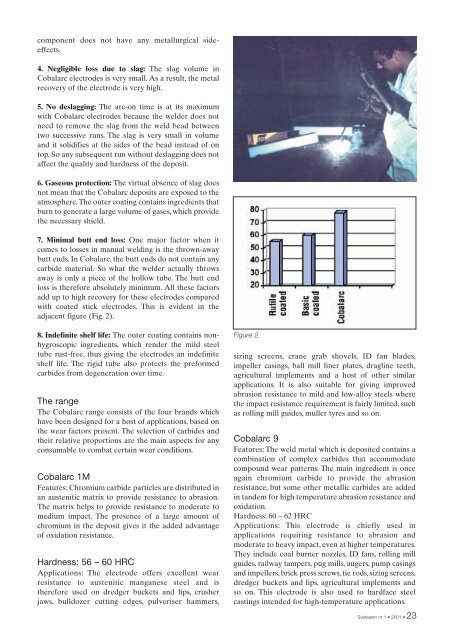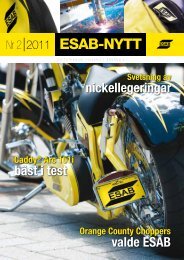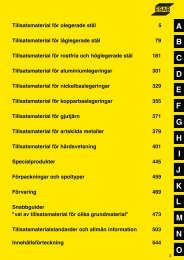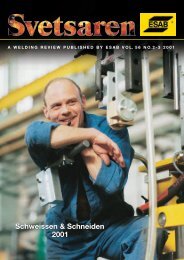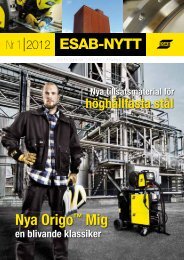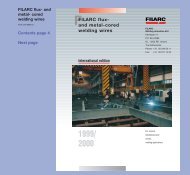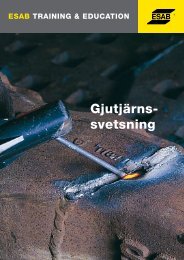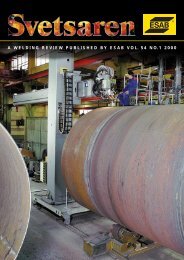Repair & Maintenance Repair & Maintenance - Esab
Repair & Maintenance Repair & Maintenance - Esab
Repair & Maintenance Repair & Maintenance - Esab
You also want an ePaper? Increase the reach of your titles
YUMPU automatically turns print PDFs into web optimized ePapers that Google loves.
component does not have any metallurgical sideeffects.<br />
4. Negligible loss due to slag: The slag volume in<br />
Cobalarc electrodes is very small. As a result, the metal<br />
recovery of the electrode is very high.<br />
5. No deslagging: The arc-on time is at its maximum<br />
with Cobalarc electrodes because the welder does not<br />
need to remove the slag from the weld bead between<br />
two successive runs. The slag is very small in volume<br />
and it solidifies at the sides of the bead instead of on<br />
top. So any subsequent run without deslagging does not<br />
affect the quality and hardness of the deposit.<br />
6. Gaseous protection: The virtual absence of slag does<br />
not mean that the Cobalarc deposits are exposed to the<br />
atmosphere.The outer coating contains ingredients that<br />
burn to generate a large volume of gases, which provide<br />
the necessary shield.<br />
7. Minimal butt end loss: One major factor when it<br />
comes to losses in manual welding is the thrown-away<br />
butt ends. In Cobalarc, the butt ends do not contain any<br />
carbide material. So what the welder actually throws<br />
away is only a piece of the hollow tube. The butt end<br />
loss is therefore absolutely minimum. All these factors<br />
add up to high recovery for these electrodes compared<br />
with coated stick electrodes. This is evident in the<br />
adjacent figure (Fig. 2).<br />
8. Indefinite shelf life: The outer coating contains nonhygroscopic<br />
ingredients, which render the mild steel<br />
tube rust-free, thus giving the electrodes an indefinite<br />
shelf life. The rigid tube also protects the preformed<br />
carbides from degeneration over time.<br />
The range<br />
The Cobalarc range consists of the four brands which<br />
have been designed for a host of applications, based on<br />
the wear factors present. The selection of carbides and<br />
their relative proportions are the main aspects for any<br />
consumable to combat certain wear conditions.<br />
Cobalarc 1M<br />
Features: Chromium carbide particles are distributed in<br />
an austenitic matrix to provide resistance to abrasion.<br />
The matrix helps to provide resistance to moderate to<br />
medium impact. The presence of a large amount of<br />
chromium in the deposit gives it the added advantage<br />
of oxidation resistance.<br />
Hardness: 56 – 60 HRC<br />
Applications: The electrode offers excellent wear<br />
resistance to austenitic manganese steel and is<br />
therefore used on dredger buckets and lips, crusher<br />
jaws, bulldozer cutting edges, pulveriser hammers,<br />
Figure 2.<br />
sizing screens, crane grab shovels, ID fan blades,<br />
impeller casings, ball mill liner plates, dragline teeth,<br />
agricultural implements and a host of other similar<br />
applications. It is also suitable for giving improved<br />
abrasion resistance to mild and low-alloy steels where<br />
the impact resistance requirement is fairly limited, such<br />
as rolling mill guides, muller tyres and so on.<br />
Cobalarc 9<br />
Features: The weld metal which is deposited contains a<br />
combination of complex carbides that accommodate<br />
compound wear patterns. The main ingredient is once<br />
again chromium carbide to provide the abrasion<br />
resistance, but some other metallic carbides are added<br />
in tandem for high temperature abrasion resistance and<br />
oxidation.<br />
Hardness: 60 – 62 HRC<br />
Applications: This electrode is chiefly used in<br />
applications requiring resistance to abrasion and<br />
moderate to heavy impact, even at higher temperatures.<br />
They include coal burner nozzles, ID fans, rolling mill<br />
guides, railway tampers, pug mills, augers, pump casings<br />
and impellers, brick press screws, tie rods, sizing screens,<br />
dredger buckets and lips, agricultural implements and<br />
so on. This electrode is also used to hardface steel<br />
castings intended for high-temperature applications.<br />
Svetsaren nr 1 • 2001 • 23


